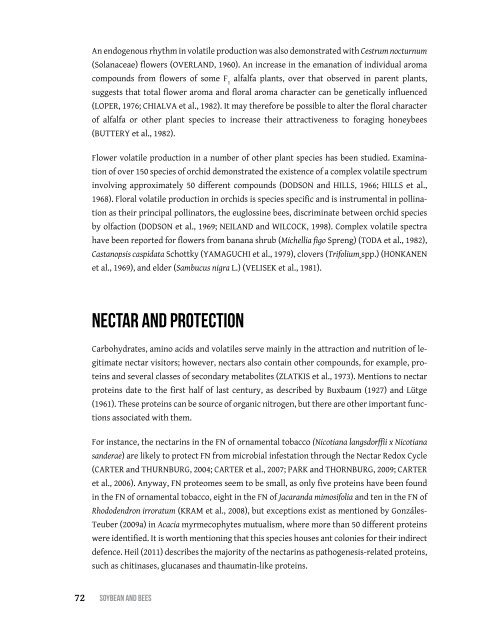Soybean and Bees
Create successful ePaper yourself
Turn your PDF publications into a flip-book with our unique Google optimized e-Paper software.
An endogenous rhythm in volatile production was also demonstrated with Cestrum nocturnum<br />
(Solanaceae) flowers (Overl<strong>and</strong>, 1960). An increase in the emanation of individual aroma<br />
compounds from flowers of some F 1<br />
alfalfa plants, over that observed in parent plants,<br />
suggests that total flower aroma <strong>and</strong> floral aroma character can be genetically influenced<br />
(Loper, 1976; CHIALVA et al., 1982). It may therefore be possible to alter the floral character<br />
of alfalfa or other plant species to increase their attractiveness to foraging honeybees<br />
(BUTTERY et al., 1982).<br />
Flower volatile production in a number of other plant species has been studied. Examination<br />
of over 150 species of orchid demonstrated the existence of a complex volatile spectrum<br />
involving approximately 50 different compounds (Dodson <strong>and</strong> Hills, 1966; Hills et al.,<br />
1968). Floral volatile production in orchids is species specific <strong>and</strong> is instrumental in pollination<br />
as their principal pollinators, the euglossine bees, discriminate between orchid species<br />
by olfaction (Dodson et al., 1969; NEILAND <strong>and</strong> WILCOCK, 1998). Complex volatile spectra<br />
have been reported for flowers from banana shrub (Michellia figo Spreng) (Toda et al., 1982),<br />
Castanopsis caspidata Schottky (Yamaguchi et al., 1979), clovers (Trifolium spp.) (Honkanen<br />
et al., 1969), <strong>and</strong> elder (Sambucus nigra L.) (Velisek et al., 1981).<br />
Nectar <strong>and</strong> protection<br />
Carbohydrates, amino acids <strong>and</strong> volatiles serve mainly in the attraction <strong>and</strong> nutrition of legitimate<br />
nectar visitors; however, nectars also contain other compounds, for example, proteins<br />
<strong>and</strong> several classes of secondary metabolites (ZLATKIS et al., 1973). Mentions to nectar<br />
proteins date to the first half of last century, as described by Buxbaum (1927) <strong>and</strong> Lütge<br />
(1961). These proteins can be source of organic nitrogen, but there are other important functions<br />
associated with them.<br />
For instance, the nectarins in the FN of ornamental tobacco (Nicotiana langsdorffii x Nicotiana<br />
s<strong>and</strong>erae) are likely to protect FN from microbial infestation through the Nectar Redox Cycle<br />
(Carter <strong>and</strong> Thurnburg, 2004; Carter et al., 2007; Park <strong>and</strong> Thornburg, 2009; Carter<br />
et al., 2006). Anyway, FN proteomes seem to be small, as only five proteins have been found<br />
in the FN of ornamental tobacco, eight in the FN of Jacar<strong>and</strong>a mimosifolia <strong>and</strong> ten in the FN of<br />
Rhododendron irroratum (Kram et al., 2008), but exceptions exist as mentioned by Gonzáles-<br />
Teuber (2009a) in Acacia myrmecophytes mutualism, where more than 50 different proteins<br />
were identified. It is worth mentioning that this species houses ant colonies for their indirect<br />
defence. Heil (2011) describes the majority of the nectarins as pathogenesis-related proteins,<br />
such as chitinases, glucanases <strong>and</strong> thaumatin-like proteins.<br />
72 SoybeAn <strong>and</strong> bees


